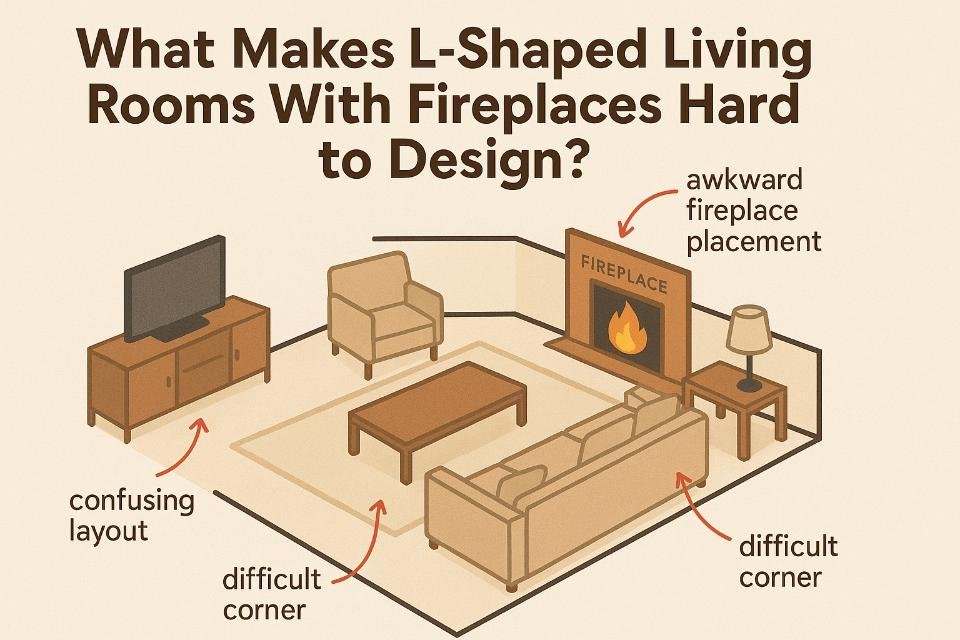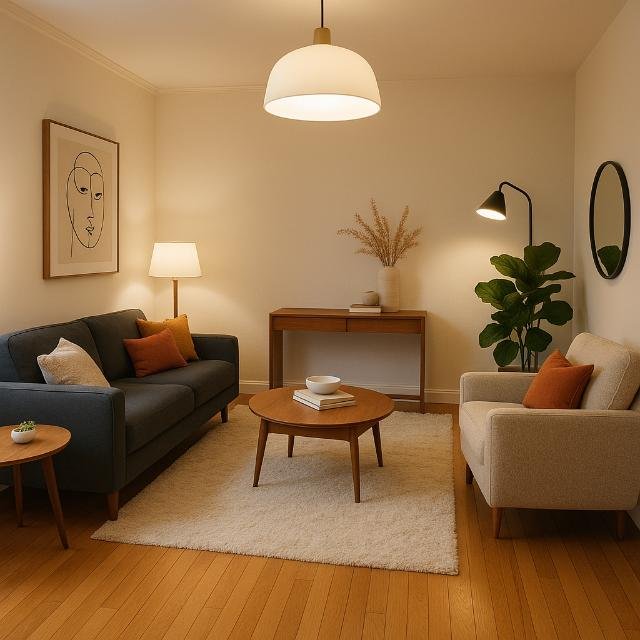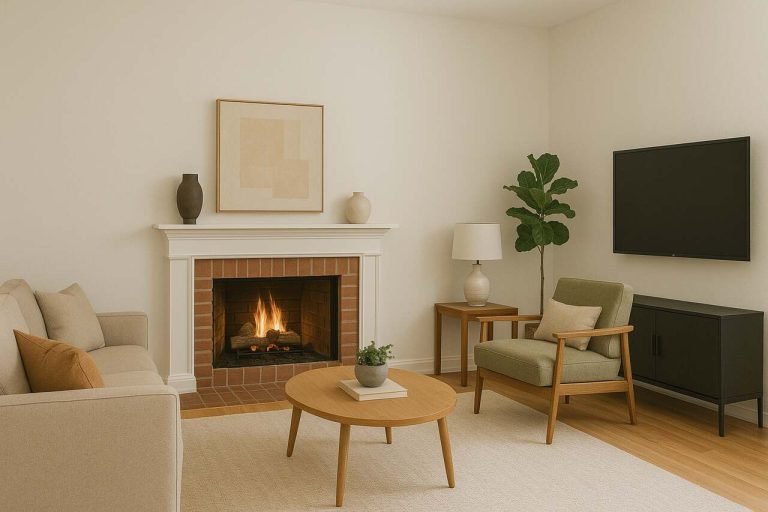L-shaped living rooms with awkward fireplaces present unique design challenges that affect both furniture arrangement and overall room functionality. These asymmetrical layouts often include angled corners, off-center fireplaces, and interrupted traffic flow, making it difficult to define a unified focal point. This article provides comprehensive solutions for these irregular spaces by examining layout zoning strategies, sectional sofa configurations, floating furniture options, and dual-focal arrangements. Readers will learn how to balance visual weight, improve circulation, and use lighting and accessories to create cohesive, functional zones. Each section connects key entities such as the fireplace, focal point, traffic flow, and sectional sofa directly to the overarching spatial challenge of optimizing awkward L-shaped rooms.
What Makes L-shaped Living Rooms With Fireplaces Hard to Design?

L-shaped living rooms become difficult to design when a fireplace introduces a conflicting focal point, disrupting spatial symmetry and limiting furniture options. These irregular rooms challenge layout consistency because the L-shape alters expected sightlines, while the fireplace often sits in a corner or wall that competes with the TV or main seating arrangement. Without intentional zoning and focal control, the space can feel visually disjointed and inefficient.
Why Do Corner Fireplaces Disrupt Layout Symmetry?
Corner fireplaces are typically angled or off-center, forcing furniture away from linear alignment and making it difficult to arrange seating without sacrificing flow. They pull attention diagonally, breaking the natural axis of the room. This asymmetry distorts balance, making one part of the room feel heavier or more important than the other. Traditional layout techniques relying on symmetry fail in this situation, requiring creative focal splitting, angled furniture, or visual framing to restore harmony.
How Does an L-shape Affect Traffic Flow and Focal Points?
An L-shaped floor plan naturally divides the space into two zones, usually with differing widths and depths. This split complicates furniture placement because users must accommodate movement between both zones while maintaining visual connectivity. Traffic often flows through the bend of the L, interrupting potential seating areas. If the fireplace is in one leg of the L and the TV or window in another, deciding on a single focal point becomes difficult. Users must consider multi-directional flow and distribute visual weight to unify the space.
How Can You Zone an L-shaped Room With a Fireplace Effectively?
Zoning allows an L-shaped room to support multiple functions without feeling fragmented. Effective zoning considers how furniture, rugs, lighting, and the fireplace work together to define clear, purposeful areas. Instead of forcing a one-size-fits-all focal point, dividing the space into zones based on function helps achieve balance and usability.
What Are the Best Ways to Divide Space for Function and Flow?
The best strategy is to divide the room into two main functional zones: a main seating area and a secondary activity zone. Visual separation through rugs, lighting, and furniture orientation allows each zone to serve its purpose without disrupting overall flow
- Use area rugs: Different rugs for each zone visually separate uses without adding physical dividers.
- Orient furniture toward each focal point: Place the sofa toward the TV and use accent chairs to face the fireplace.
- Use a console or bookshelf as a soft divider: Helps segment zones without closing them off.
- Maintain clear walkways: Leave 30 inches minimum between zones for unimpeded circulation.
Can a Sectional Sofa Help Unify Zones?
A sectional sofa acts as both a visual anchor and a functional room divider. When placed at the intersection of the L-shape, the sectional bridges both zones, guiding traffic and linking focal points.
- L-shaped sectionals: Fit naturally into the room’s shape and reduce dead corners.
- Chaise end toward the fireplace: Creates a cozy sub-zone while maintaining a view of the main area.
- Floating sectional setup: Separates space without closing it off from circulation.
- Modular sectionals: Allow changes in shape as usage evolves or during seasonal shifts.
How Do You Handle the Fireplace in an Awkward Corner Layout?
Handling a fireplace in a corner or offset location requires deciding whether it will serve as the main focal point or act as a supporting feature. The fireplace’s visual weight must be balanced against other elements like the TV, windows, or artwork.
Should the Fireplace Be the Main Focal Point or Secondary Feature?
If the fireplace is elegant and visually prominent, it should be emphasized as the central feature. However, if it is small or awkwardly placed, it may be more effective to treat it as a secondary element.
- Make it primary when: It is centered, beautifully designed, or the only major architectural feature.
- Make it secondary when: It is cornered, asymmetrical, or blocks optimal furniture alignment.
- Balance both: Use split-focus layouts where the TV and fireplace share attention from different seating angles.
- Supplement with art or shelving: Frame the fireplace with decorative elements to increase its importance if needed.
How to Create a Cozy Fireplace Zone Without Losing Layout Logic?
Creating a cozy fireplace zone involves carving out a subsection of the room where intimacy and warmth are emphasized without conflicting with the larger layout. This micro-zone works best as a reading corner, conversation nook, or visual pause.
- Add a small loveseat or two chairs angled to the hearth: Supports informal seating.
- Use soft lighting and layered rugs: Enhance comfort and zone definition.
- Place a round coffee table or ottoman: Keeps the area functional without sharp corners.
- Use visual symmetry: Even if asymmetrical physically, mirroring shapes or lighting balances the zone.
What Are Smart Furniture Placement Strategies for Awkward Layouts?

Smart furniture placement in L-shaped rooms with a fireplace considers both spatial hierarchy and flow. Furniture should respect the shape of the room while solving functional needs like seating capacity and visibility.
Where Should the Sofa Go in an L-shaped Room With a Fireplace?
The sofa should anchor the main function of the room, typically facing the TV or central focal area. In some cases, the fireplace may serve this purpose, but often the TV remains the practical choice.
- Place it along the longer wall: Allows maximum seating length and sightline control.
- Float it to face the fireplace: When the hearth is dominant and centered.
- Tuck it into the corner of the L: Maximizes space and maintains flow between zones.
- Use back-of-sofa console: Helps frame the sofa and zone it clearly when floated.
How to Float Furniture to Maintain Openness and Visual Clarity?
Floating furniture is effective when you want to avoid wall-dependent layouts. This is especially helpful in awkward rooms where centering against a wall may not align with traffic flow or focal elements.
- Use area rugs to define the boundary: Prevents the layout from feeling adrift.
- Maintain spacing: Keep at least 30 inches behind sofas or chairs for walkways.
- Frame with lighting: Floor lamps or overhead fixtures give context to the floating group.
- Add anchors: Side tables, poufs, or storage pieces ground the floating arrangement.
What Are Layout Ideas for Different L-shape Room Sizes?
Different room sizes require different layout priorities. Small L-shaped rooms must avoid clutter while maximizing function, while larger spaces must prevent visual emptiness and echo.
What Works in Small vs. Large L-shaped Living Rooms?
Small L-shaped rooms benefit from fewer, multifunctional furniture pieces that can shift zones quickly. Large rooms
need stronger zone distinction and layered scale to avoid feeling sparse.
Small rooms:
- Use armless seating or loveseats.
- Opt for nesting tables instead of bulky coffee tables.
- Avoid overloading with accessories.
- Choose vertical storage to open floor area.
Large rooms:
- Use bold rugs and sectional sofas to define zones.
- Include a secondary lounge or reading area.
- Use large art or statement lighting to scale to volume.
- Anchor each leg of the L with function (e.g. media zone and quiet nook).
How Do You Avoid Clutter While Using the Full Space?
Clutter is avoided by assigning clear roles to each area and avoiding unnecessary duplication of functions.
- Assign specific functions to corners: For example, media zone, reading corner, kids’ play area.
- Use closed storage: Ottomans or credenzas keep messes hidden.
- Layer lighting instead of more furniture: Adds complexity without adding bulk.
- Stick to a tight color palette: Visually unifies separate areas and reduces chaos.
How Can Lighting and Accessories Enhance an Awkward Layout?

Lighting and accessories are essential in awkward rooms to visually guide the eye, reinforce zones, and correct spatial imbalance. Strategic use of light, mirrors, and scale-appropriate décor brings cohesion and clarity.
How to Use Mirrors to Expand Perceived Space?
Mirrors extend sightlines and reflect light, making tight or angular spaces feel larger and more open. Positioning is crucial to avoid visual confusion.
- Place mirrors opposite windows: Doubles the light and expands views.
- Use tall vertical mirrors: Enhance ceiling height.
- Anchor above console or fireplace: Adds weight and formality.
- Avoid facing mirrors toward clutter zones: Prevents visual noise.
Can Lighting Zones Help Guide Furniture Placement?
Lighting acts as a functional and decorative zone guide. Each lighting source highlights a purpose or task area, reinforcing layout logic.
- Pendant lighting over conversation areas: Defines where people gather.
- Wall sconces around the fireplace: Adds intimacy and visual emphasis.
- Table lamps near reading corners: Create intentional quiet zones.
- Dimmers and smart lighting: Adjust mood and use between day and night.
Where Can You Find Layout Inspiration and Planning Tools?
Inspiration and digital tools allow homeowners to preview and test awkward layout solutions before moving heavy furniture or purchasing new items.
What Free Tools Let You Visualize Fireplace Layouts?
Several free tools support layout planning for irregular spaces.
- Roomstyler 3D Home Planner: Offers drag-and-drop with furniture and fireplace modules.
- Planner 5D: Allows fireplace placement and custom room shapes.
- MagicPlan: AR scanning to create editable floor plans.
- SketchUp Free: For advanced 3D modeling and visualization.
Where to See Real-life Awkward Layout Solutions?
Real-world solutions help users relate to challenges and understand functional trade-offs.
- Reddit (r/HomeDecorating, r/InteriorDesign): User-submitted awkward room makeovers.
- Houzz: Before-and-after L-shaped room projects.
- Designer blogs: Feature case studies with commentary.
- Retailer galleries: Room sets showing layout workarounds.
Conclusion
L-shaped living rooms with awkward fireplaces demand creativity, precision, and spatial awareness. By dividing the space into functional zones, aligning furniture to visual priorities, and balancing elements like light, scale, and circulation, even the most asymmetrical layout can become harmonious and practical. Sectionals, floating arrangements, and dual focal points allow users to embrace their room’s unique form rather than fight it.
FAQ’s
Create dual zones: one for fireplace lounging and another for main seating. Use a sectional to define flow.
Yes, treat it as a secondary feature or create a cozy nook if it disrupts symmetry.
Use angled seating or an L-shaped sofa to allow visibility of both focal points.
Yes, especially to separate zones or redirect traffic around a fireplace.
No. Use it as a visual accent and prioritize layout functionality.
Rugs define zones. Use separate rugs for each area or one large rug anchoring the main space.
Modular pieces, armless loveseats, swivel chairs, and slim consoles allow flexibility in small or angular areas.
Use the long side for main seating and dedicate the other leg to reading, storage, or display.


